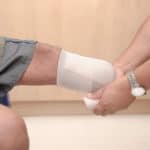Dealing with chronic pain is big business for healthcare practitioners in the 21st century. An April 2005 nationwide poll conducted by Stanford University Medical Center, ABC News and USA Today found that more than half of Americans suffer from chronic or recurrent pain, and of those surveyed, 25 percent reported back pain as a significant disability. This translates into more than 11 million Americans being significantly impaired by chronic and recurring pain, and more than 2.6 million being permanently disabled by back pain alone.
Time is repeatedly proving that chronic pain has the best outcome when a multi-disciplinary program is followed. This indicates that pain relief finds clients seeking treatment from a variety of sources. The installment of pain management centers across the country have tapped into this success by combining a facility with physicians, pharmacists, rheumatologists, physical therapists, acupuncturists, nutritionists, fitness trainers, chiropractors and of course, massage therapists. Massage therapists can further expound upon the multiple modality approach by utilizing an array of techniques to shift clients out of their pattern of chronic pain.
There are three primary categories in which pain management focuses:
- Non-invasive, non-drug pain management
- Non-invasive, pharmacologic pain management
- Invasive pain management
Non-invasive, non-drug pain management
There is a wide variety of noninvasive non-drug pain management techniques available for treating chronic pain. A few of the most widely accepted in comprehensive pain management programs are the following:
- Exercise—physical exertion with the aim of training or improvement. This can include strength training, water therapy, flexion exercises and aerobic routines involving active, passive and resistive elements. Exercise is necessary for proper cardiovascular health, disc nutrition and musculoskeletal health.
- Manual techniques—manipulation of affected areas by means of chiropractic adjustments, osteopathy, massage therapy and other tactile applications. Manual techniques use physical touch to alter tissue morphology, structure and function. The primary goal is increasing local circulation through muscle/ joint elongation and oxygenation.
- Behavioral modification—use of behavioral methods to optimize patient responses to pain and painful stimuli. Cognitive therapy involves teaching the patient to alleviate pain with relaxation and coping techniques. Biofeedback involves the gradual alteration of neuromuscular signals for symptomatic improvement.
- Cutaneous stimulation —superficial heating or cooling of skin. These pain management methods include cold packs and hot packs, and yield the best results when used in conjunction with exercise and other circulatory methods.
- Electrotherapy —the most commonly known form of electrotherapy is transcutaneous electrical nerve stimulation (TENS). TENS therapy attempts to reduce pain by means of low-voltage electric stimulation that interacts with the sensory nervous system.
Non-invasive pharmacologic pain management
Pain relievers and related drugs are used at every stage of western medicine’s treatment for chronic pain. The most common noninvasive pharmacologic treatments for chronic back pain are:
- Analgesics—includes acetaminophen. Long-term use involves risk of kidney damage.
- Nonsteroidal anti-inflammatory agents (NSAIDs)—includes aspirin, ibuprofen, naproxen, and the controversial COX-2 inhibitors.
- Muscle relaxants—used to treat muscle spasms due to pain and protective mechanisms.
- Narcotic medications—most appropriate for acute or post-operative pain. Since the use of narcotics entails risk of habituation or addiction if not properly supervised, they are seldom used for chronic conditions.
- Antidepressants and anticonvulsants— primarily used to treat nerve pain. However, an increasing number of physicians are experimenting with their use for all kinds of chronic pain syndromes.
Invasive pain management techniques
Invasive techniques in pain management involve invasion of instruments and devices into the body. In general, surgery is not included in pain management, so invasive pain management techniques typically are less traumatic to the body than surgery. Some of the most popular invasive pain management therapies include:
- Injections—direct delivery of steroids or anesthetic to nerve, joint or epidural space. Injections into the facet, peripheral nerve, trigger point and other locations are also known as “blocks”. These may provide relief of pain (often temporary) and can be used to confirm diagnosis.
- Prolotherapy—injection of a solution to stimulate blood circulation and ligament repair at the affected site.
- Surgically implanted electrotherapy devices—implantable spinal cord stimulators (SCS) and implantable peripheral nerve stimulators. This is essentially an internal TENS device.
- Implantable opioid infusion pumps—surgically implanted pumps that deliver opioid agents directly to an affected nerve. Typically a last resort, this technique carries a high risk of addiction.
- Radiofrequency radioablation—deadening of painful nerve via heat produced by a specialized device.
Massage Therapy’s Role
Massage therapy’s role in pain management can be substantial. Fitting into the safest category with the best long-term outcome, massage is an excellent, non-invasive, non-drug, pain management, manual technique. Analogous to the overall pain management approach of inter-disciplinary healing, the reliance on a variety of massage techniques will give your client the greatest chance for pain relief. In order to visualize this approach, begin by imagining a stream filled with debris that prevents water from flowing downstream. With the goal of increasing water flow, one could choose from the following strategies:
- Physically removing the debris
- Digging a trench around the debris to encourage flow
- Opening an upstream dam to naturally force the debris through
- Pulverizing the debris
A comprehensive approach to increase your success rate would be combining all of the above. A massage therapist can take advantage of this comprehensive approach by relying on a variety of massage techniques, such as Swedish massage, Reflexology, Neuromuscular Therapy, Myofascial Release, reiki, or acupressure. In addition to collaborating with other healthcare professionals, diversifying within one’s own field will amplify your effectiveness. When choosing to enter the ever-growing market of pain management, keep all of these integrative concepts in mind for the ultimate benefit to your clients and your practice.
Recommended Study:
Myofascial Release, Neuromuscular Therapy, Reflexology, Shiatsu Anma Massage, and Swedish Massage for Professionals.















